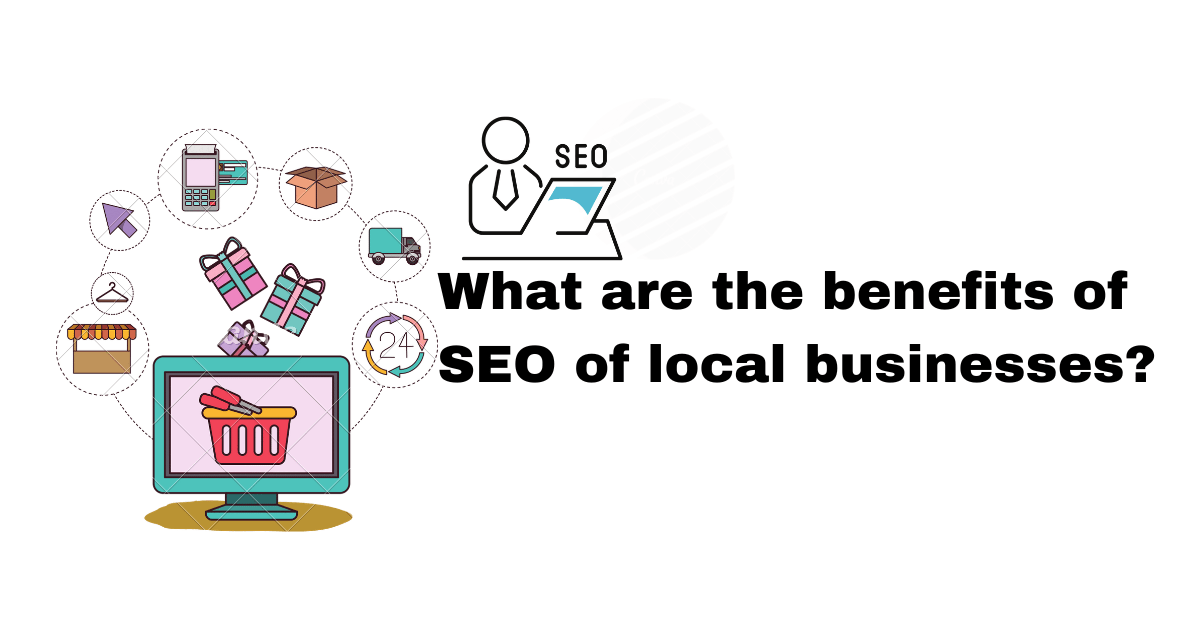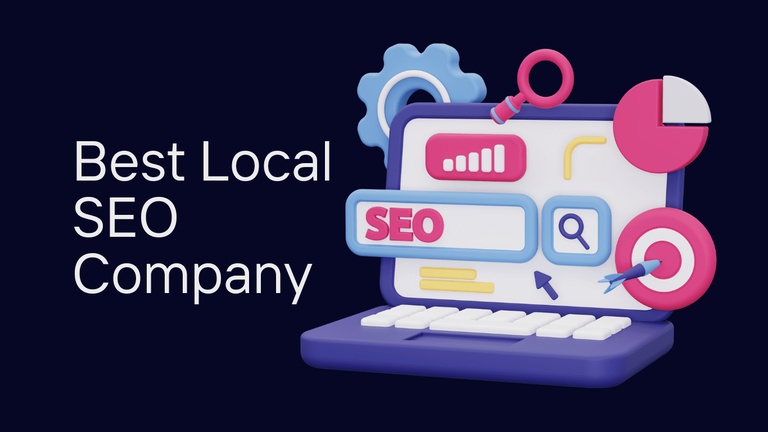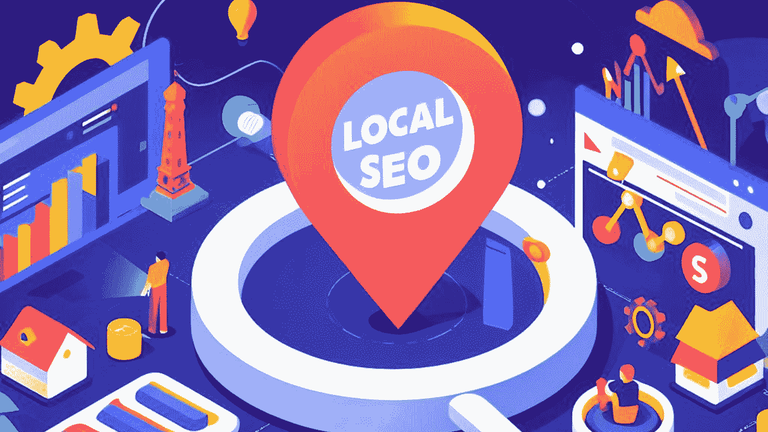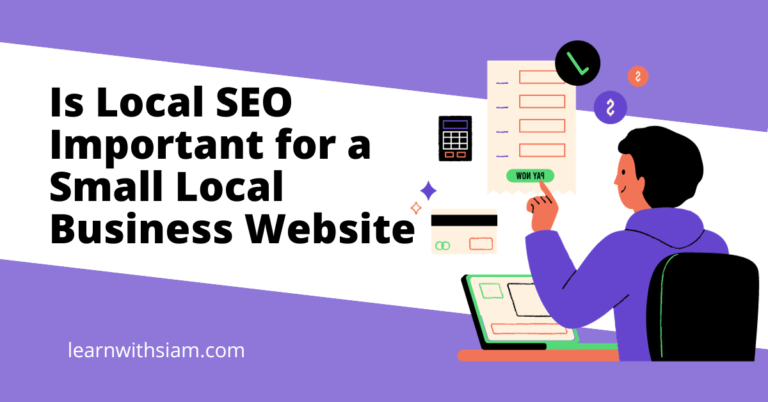What are the benefits of SEO of local businesses?
What are the benefits of SEO of local businesses? Small businesses may enhance their online presence and engage more clients by using local SEO, which is a potent strategy. Businesses may take advantage of the local shopping boom by improving their Google presence, generating more leads, subscriptions, and sales. A thought leadership position may be developed through Google My Business optimization, which increases calls and in-person visits.
Online reviews support decision-making, and reputation management raises trust levels. Increases in phone calls, purchases, and submissions to contact forms can all be attributed to higher conversion rates on websites. Through analysis of rivals’ tactics, local SEO also helps businesses become more competitive.
Local SEO may help small businesses enhance their online presence and attract more clients. You may connect with individuals in your neighborhood, town, or city by improving your Google presence. Here are some advantages to local SEO:
Improved online exposure: Local SEO activities like citation and link building boost your online presence. This increases the likelihood of new clients discovering your company.
Increased in-store foot traffic: Greater local presence increases foot traffic to your physical site.
Take advantage of the local shopping boom: Following the implementation of COVID, more than half of customers now choose to buy locally and support local businesses or smaller brands. Local SEO puts you in the running for new business prospects.
Focused web traffic: Optimizing your site for local search results in more focused traffic to your website, which may lead to more leads, subscriptions, sign-ups, and sales.
More calls: Google Business Profile (previously known as Google My Business) improvement can lead to improved Google Maps exposure. This may result in increased calls and in-person visits.
Thought leadership: Content marketing may help you build thought leadership and establish yourself as an expert in your subject.
Increased trust: Reputation management fosters trust in your business.
More sales: It is common for customers to consult internet reviews to aid in their decision-making when selecting a local business.
Improved conversion rate: Improving your conversion rate can increase contact form submissions, phone calls, email subscriptions, or sales.
More competitive: Local SEO makes you more competitive by encouraging you to research what your competitors are doing well and what methods are working for them, which you can then incorporate into your own strategy.
Small businesses may gain a competitive advantage over big businesses and boost their chances of success by employing local SEO methods.
What are some local SEO strategies?
What are the benefits of SEO of local businesses? Local SEO strategies can assist businesses in increasing their online presence and attracting new clients. Businesses may attract more clients by improving their Google Business Profile, interacting on social media, and maintaining consistent NAP information. A local SEO audit might uncover areas for improvement, like metadata and internal linking structure optimization.
Increasing website exposure through obtaining backlinks from local sources, generating location-specific content, and strengthening internal linking structure. Regularly updating information and monitoring reviews on sites such as Google My Business may also aid in the development of trust among potential clients. Businesses may boost their web presence and attract more clients in their local region by applying these methods.
Here are some local SEO tactics that might assist businesses in increasing their internet presence and attracting more customers:
Optimize your Google Business Profile: Ensure that your business’s information on your Google Business Profile is correct, thorough, and up to date. This will make it easier for potential consumers to locate you when they search for local businesses.
Engage on social media: Post updates, promotions, and relevant information on social media channels on a regular basis. Additionally, make posts to your Google Business Profile to improve interaction and visibility.
Make that your business’s name, address, and phone number (NAP) are consistent throughout all web directories and citations. This uniformity aids search engines in comprehending and verifying your business’s information.
Perform a local SEO audit: Analyze the success of your website in local search results. Identify opportunities for improvement, such as metadata optimization, internal linking structure improvement, and user experience enhancement.
Optimize for local keywords: Conduct keyword research to uncover keywords that are relevant to your area. To boost local search rankings, use these keywords throughout your website’s metadata, body text, URLs, and content.
Obtain backlinks from local sources: Look for ways to obtain backlinks from other respected local websites or businesses. Backlinks from local sources can increase the authority and visibility of your website in local search results.
Make location-specific content: Create material that is suited to your local audience. Mention local markers, events, or hotspots to establish your relevance to the community.
Improve internal linking structure: Include internal connections between location-specific pages on your website. This assists search engines in understanding the relationship between distinct pages and increases overall website exposure.
Regularly update your website: Keep your website material fresh and up to date. Regularly publish fresh blog entries, update product/service information, and ensure that your website is mobile-friendly.
Monitor and respond to reviews: Encourage consumers to submit evaluations on networks like Google My Business. Monitor these reviews and reply quickly to establish confidence with future consumers.
Keep in mind that local SEO is a continual activity that needs constant monitoring and modification. You may boost your web presence and attract more clients in your local region by applying these methods.
How can I improve my website’s user experience?
What are the benefits of SEO for local businesses? Optimizing your website’s design, page speed, using attractive calls to action, differentiating hyperlinks, segmenting key information with bullet points, using relevant images, including well-designed headlines, maintaining a consistent layout, identifying 404s, and ensuring responsiveness and mobile-friendliness all contribute to improving the user experience.
To develop an amazing user experience, it’s essential to continuously monitor user input, conduct A/B testing, and make data-driven enhancements. This approach not only aids in attracting and retaining visitors but also enhances the overall user experience.
Enhancing the user experience of your website is crucial for attracting and retaining visitors. Here are some suggestions for improving your website’s user experience:
- Simplify the website’s design: A clean and simple design facilitates easy navigation for visitors.
- Optimize page speed: Ensure that your website loads quickly to prevent users from leaving due to slow loading times.
- Use aesthetically appealing and compelling calls to action: Engage users with visually appealing and persuasive calls to action.
- Use hyperlink differentiation: Make hyperlinks easily distinguishable from regular text to enhance navigation.
- Use bullet points to present important information: Improve readability by breaking down essential information into concise bullet points.
- Use images judiciously: Include relevant images to enhance your website’s aesthetic appeal.
- Include well-crafted headlines: Utilize catchy headlines that effectively describe the purpose of each section.
- Maintain consistency across pages: Ensure that the layout, color scheme, and typography remain consistent for a unified user experience.
- Monitor and rectify 404 errors: Regularly check for broken links and ensure that users are directed to the appropriate pages when issues arise.
- Make your website responsive and mobile-friendly: Optimize it for various devices to provide a consistent user experience across all platforms.
Remember that enhancing the user experience is an ongoing process. Continuously monitor user feedback, conduct A/B testing, and make data-driven improvements to deliver an exceptional user experience.”
How can I optimize my website for mobile devices?
Are you wondering about the benefits of SEO for local businesses? Testing your website’s performance with Google’s Mobile-Friendly Tool, using a responsive WordPress theme, selecting a dependable web host, improving loading times, redesigning pop-ups for mobile devices, enabling Accelerated Mobile Pages (AMP), and developing a mobile app are all part of optimizing your website for mobile devices. Regular performance monitoring and user input are critical for improving the user experience and guaranteeing faster loading times.
Follow these tactics to improve your website for mobile devices:
- Use Google’s Mobile-Friendly Tool to test your site: This tool assists you in evaluating the mobile performance of your site and identifying areas for improvement.
- Use a responsive WordPress theme: Select a theme that adjusts to multiple screen widths and gives the best user experience possible.
- Select a dependable web host: The correct web host can guarantee that your site loads quickly and operates effectively on mobile devices.
- Optimize your website’s performance to avoid people from leaving due to sluggish loading times.
- Make your pop-ups mobile-friendly: Make sure pop-ups are mobile-friendly and don’t interfere with the user experience.
- Enable Accelerated Mobile Pages (AMP): Use AMP to improve mobile surfing performance and user experience.
- Develop a mobile app: If applicable, a mobile app can provide a dedicated platform for consumers to interact with your content.
Keep in mind that optimizing your website for mobile devices is a continuous activity. Monitor your site’s performance on a regular basis, collect user feedback, and make data-driven modifications to optimize the mobile user experience.
How can I improve my site’s loading times?
What are the benefits of SEO for local businesses? Consider implementing strategies such as a fast infrastructure, using a Content Delivery Network (CDN), compressing files with Gzip, reducing HTTP requests, minimizing CSS and JavaScript, streamlining HTML, optimizing images for faster page load times, and cleaning up the media library to improve website loading times. These tactics can help your website load quicker and more efficiently, but each website’s configuration may necessitate extra adjustments.
Use the following ways to enhance the loading speeds of your website:
- Set up a quick infrastructure or utilize a quick host: Begin by ensuring that you have the necessary infrastructure or hosting provider in place to ensure quick loading speeds.
- Use a Content Delivery Network (CDN): Using a CDN can help your website’s content be delivered more effectively to users all around the world.
- Use Gzip for file compression: Gzip compression can reduce file size and improve loading times.
- Reduce the number of HTTP requests: Reduce the number of HTTP requests sent by your website to the server, as each request increases loading time.
- Minify CSS and JavaScript: To minimize the size of your CSS and JavaScript files, remove any extraneous characters and spaces.
- Simplify your HTML: Remove unneeded tags, comments, and white spaces from your HTML code.
- Image optimization for quicker website load time: Compress and resize images without sacrificing quality to minimize file size.
- Clean up your media library: To minimize storage and improve loading speeds, remove unwanted media files from your website’s media library.
These are some broad ideas for improving the loading times of your website. However, keep in mind that each website is unique, and more adjustments may be necessary depending on your individual setup.
How can I compress images without losing quality?
Consider fast infrastructure, using a Content Delivery Network (CDN), compressing files with Gzip, reducing HTTP requests, minimizing CSS and JavaScript, streamlining HTML, optimizing images for faster page load times, and cleaning up the media library to improve website loading times. These tactics can help your website load quicker and more efficiently, but each website’s configuration may necessitate further adjustments.
There are various methods for compressing photos without sacrificing quality. Here are several approaches you can take:
- Use an online image compressor: There are several free online applications for compressing photographs without sacrificing quality. You might, for example, use Image Compressor or Img2Go.
- Use image editing software: Applications such as Adobe Photoshop or GIMP allow you to compress images while maintaining their quality. To compress your photographs, utilize Photoshop’s “Save for Web” function or GIMP’s “Export As” feature.
- Resizing your photographs to a lower resolution can minimize their file size without harming their quality. However, if you need to keep your photographs at their original size, this solution may not be viable.
- Use a lossless compression format: Lossless compression formats, such as PNG and GIF, may compress pictures without sacrificing quality. These formats, however, may not be appropriate for all sorts of photographs.
What is the difference between lossless and lossy compression?
Lossless compression and lossy compression are data compression algorithms that recover and recreate data in its original form after decompression. Lossless compression restores compressed files to their original form with no data loss, whereas lossy compression recovers huge files with little data loss.
Both systems have their own compression algorithms, with lossless compression concentrating on Run Length Encoding and lossy compression focused on Transform coding. Their use cases differ based on the application.
The following are some important distinctions between lossless and lossy compression:
- Data Restoration: Lossless compression returns the compressed file to its original form with no data loss, whereas lossy compression restores the huge file to its original form with some data loss, which is frequently deemed minor.
- Data Quality: Lossless compression does not degrade data quality, however lossy compression may degrade data quality owing to the removal of non-noticeable information.
- amount Reduction: Lossless compression decreases the amount of data to a lesser extent than lossy compression, which can drastically reduce the size of a file.
- Algorithms for Lossless Compression: Lossless compression algorithms include Run Length Encoding, Lempel-Ziv-Welch, Huffman Coding, and Arithmetic Encoding. Transform coding, Discrete Cosine Transform, Discrete Wavelet Transform, and fractal compression are all lossy compression methods.
- Lossless compression is often used to compress text, pictures, and audio data. Image, audio, and video data are frequently compressed using lossy compression.
It is important to remember that the use cases for lossless and lossy compression varies based on the unique needs of a given application.
How can I choose between lossless and lossy compression?
Lossy compression is a way for reducing file size while keeping quality, and it is commonly used for picture, audio, and video files. It is appropriate for applications that demand data integrity, whilst others may emphasize reduced file sizes.
The decision between lossless and lossy compression is determined by the application’s unique needs, user experience, and available bandwidth. Both strategies can improve the overall user experience and cut transfer times.
Explore the following variables while deciding between lossless and lossy compression:
- Data Importance: Lossless compression is the method to go if keeping the original data without loss is critical. This is especially critical for written documents or data that must be exact.
- File Size: If file size reduction is a requirement and a minor loss of quality is acceptable, lossy compression can dramatically reduce file size while keeping decent visual or audio quality. This is frequently used for photos, audio files, and video files.
- Application requirements: Consider your application’s specific requirements. Some applications may need lossless compression to preserve data integrity, but others may favor reduced file sizes and allow some quality loss.
- User Experience: If your application contains multimedia material, such as photographs or videos, consider how compression may affect the user experience. Lossy compression may result in quicker loading times and smoother playback, ultimately improving the user experience.
- Lossy compression might assist minimize transfer times owing to reduced file sizes if you have limited bandwidth or need to communicate data rapidly.
Finally, the decision between lossless and lossy compression is determined by your individual demands and objectives. To make an educated selection, consider the relevance of data integrity, file size reduction, application needs, user experience, and available bandwidth.






